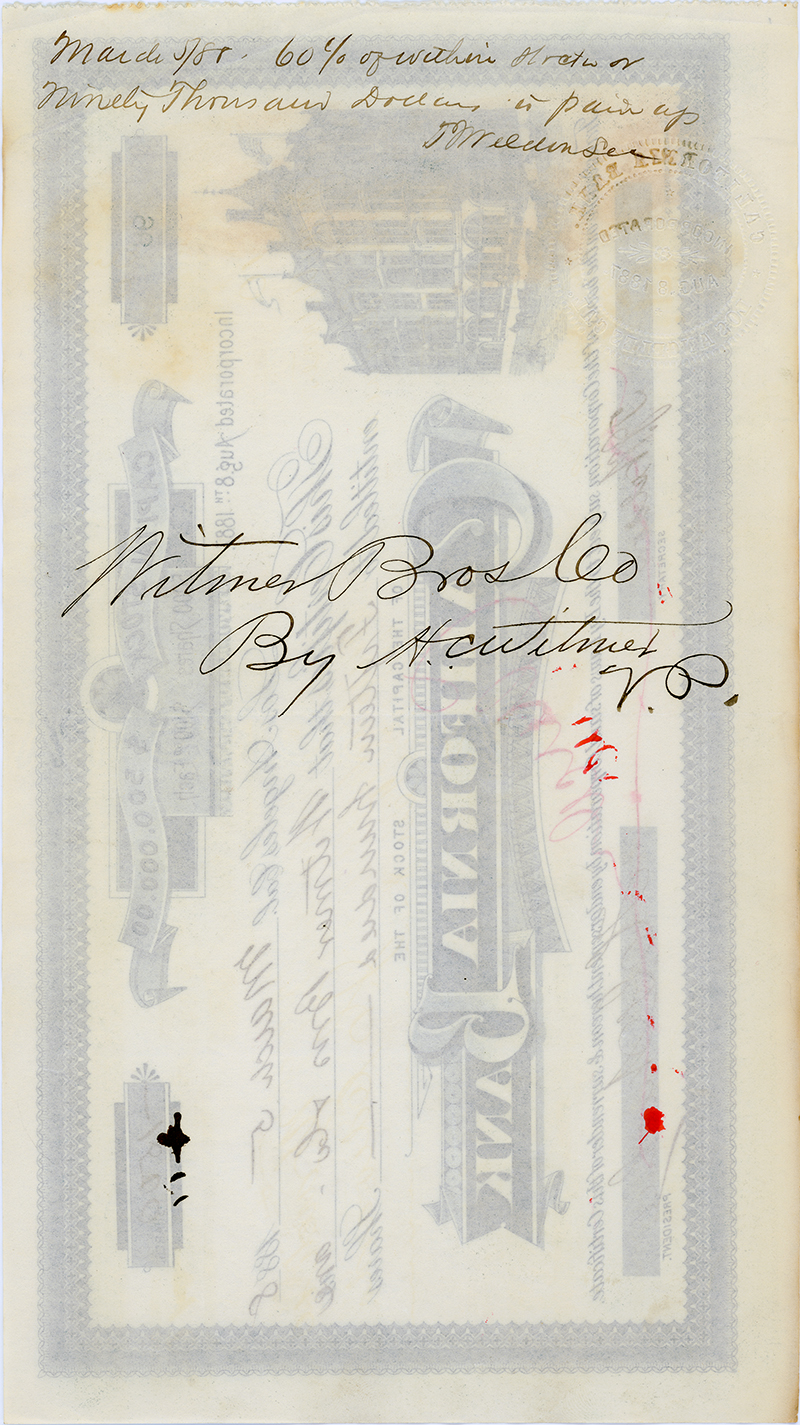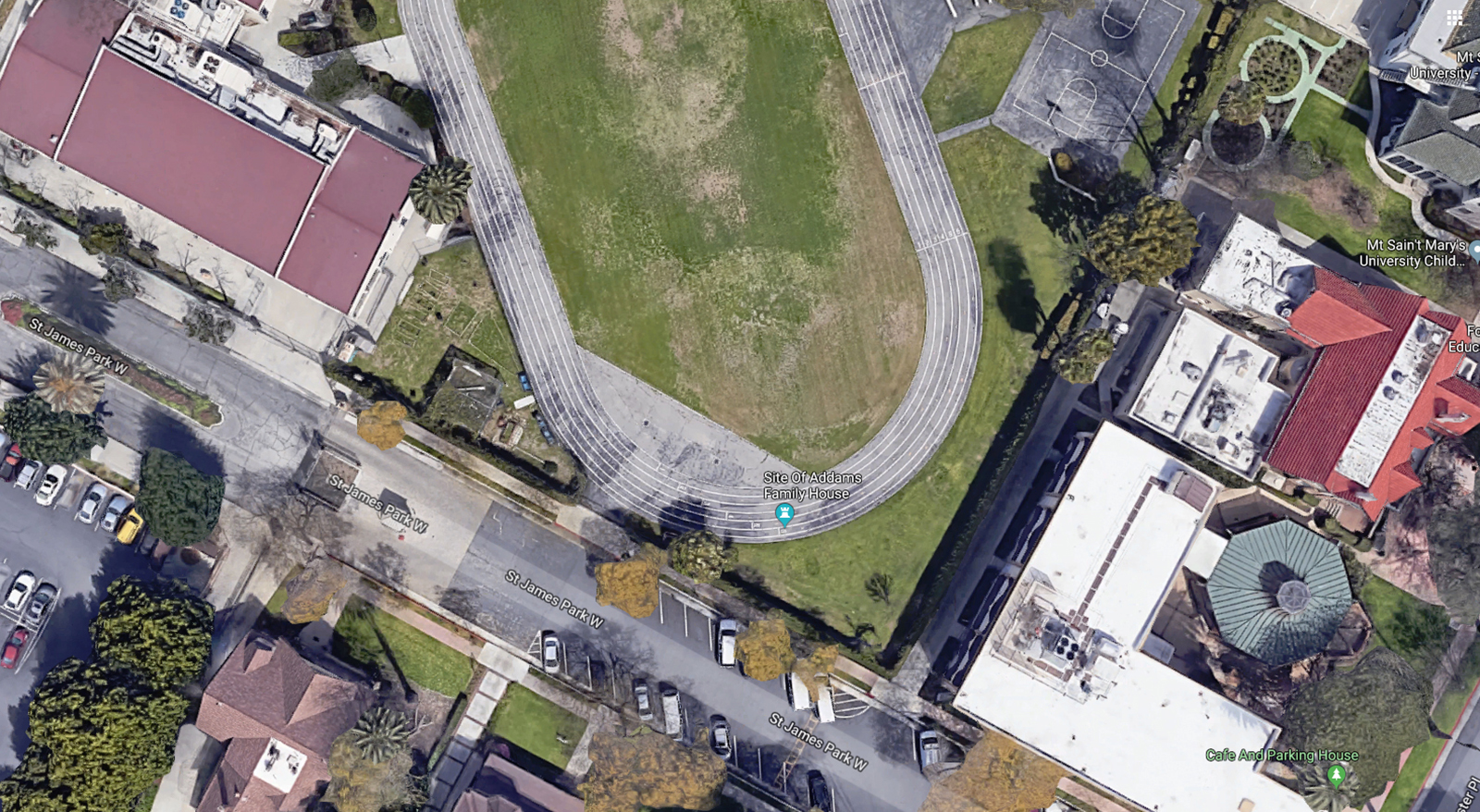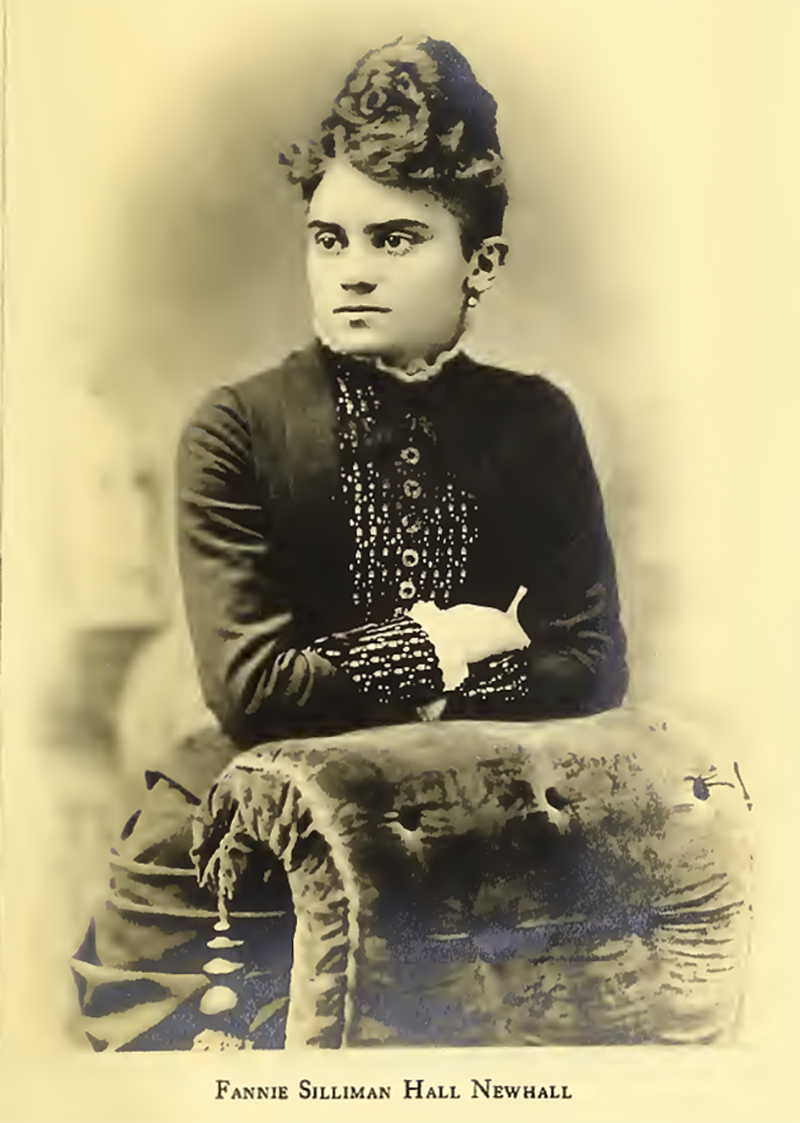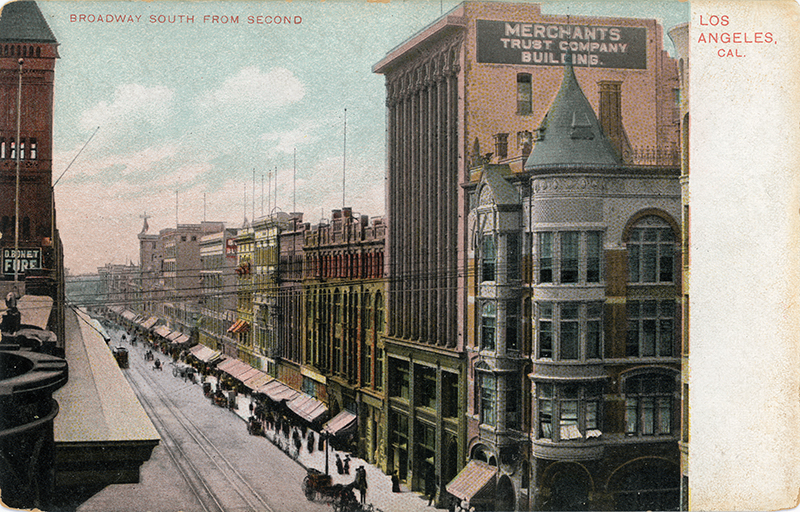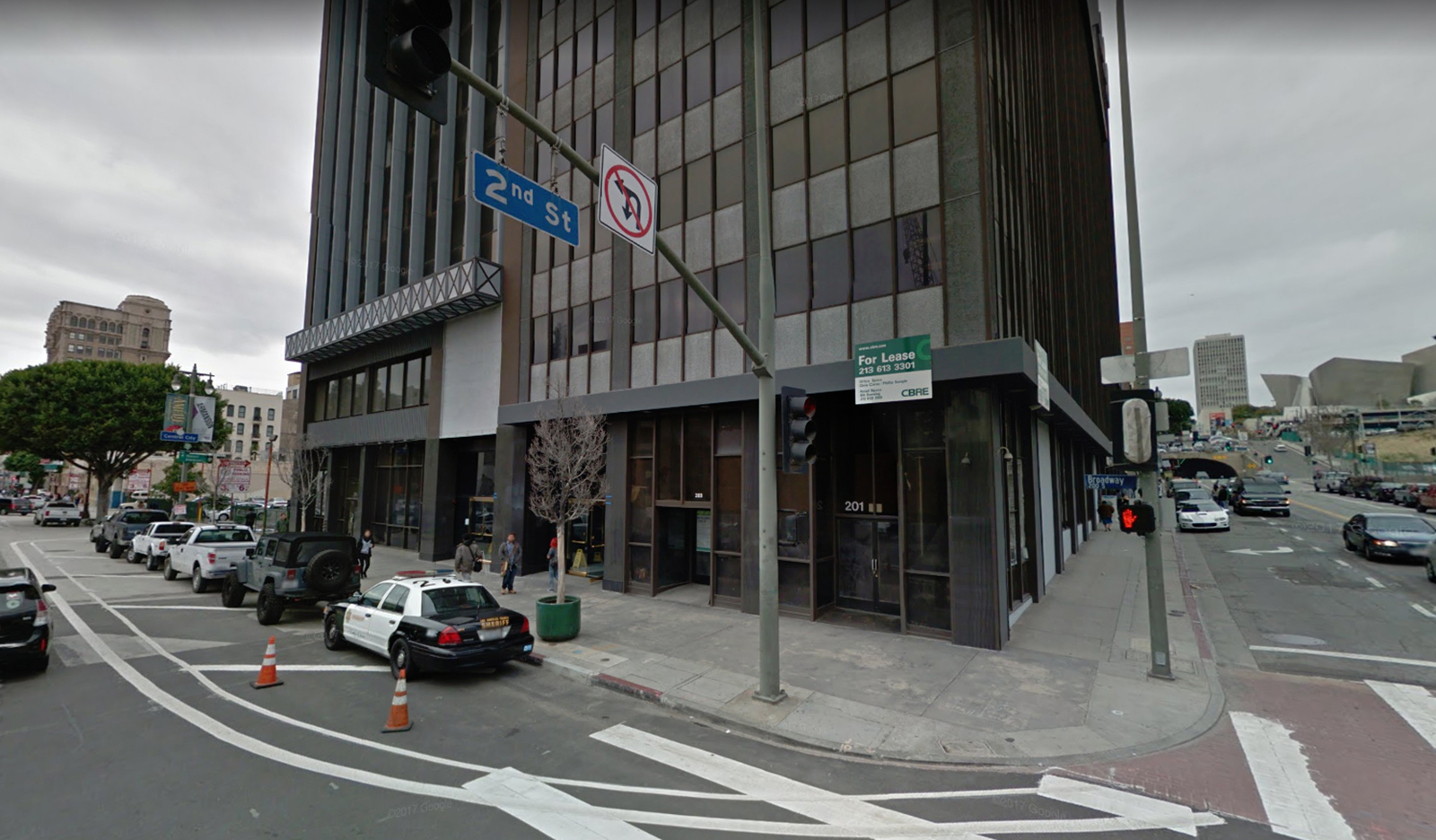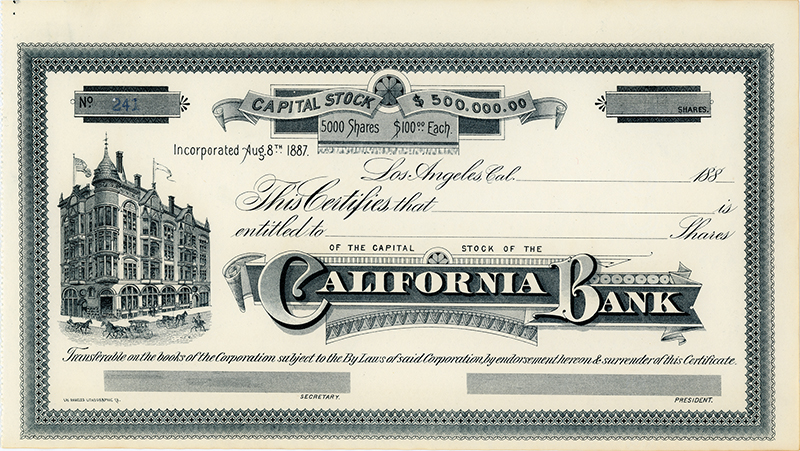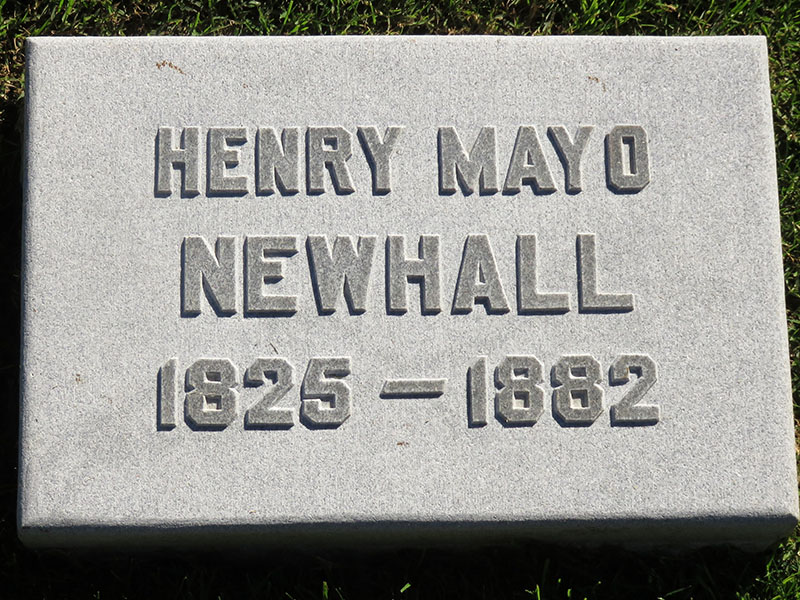|
|


Click image to enlarge
| Download archival scan
California Bank (of Los Angeles) stock certificate issued March 5, 1888, to Witmer Bros. & Co., signed by Henry Gregory Newhall during his 1- or 2-year tenure as president of the bank. Rare. Endorsed by Henry Clayton Witmer, manager of California Bank and vice president of Witmer Bros. His brother, Joseph M. Witmer, was a cashier for the bank. 1,500 shares, par value $100. Also: Unissued stock certificate shown at bottom.
YOUNG NEWHALLS IN LOS ANGELES. This is a story of young, second-generation San Franciscans in their 20s trying to capitalize on, and contributing to, the speculative real-estate frenzy that beset Los Angeles in the late 1880s. Henry Gregory Newhall was the oldest of five sons of San Francisco auctioneer and eponymous Santa Clarita Valley town founder Henry Mayo Newhall. Because of his age and education, Henry Gregory was named founding president of The Newhall Land and Farming Company. Henry Mayo's heirs formed the land company about a year after the patriarch's untimely death in 1882, to manage his vast California real-estate holdings. One such holding was the Rancho San Francisco, comprising 48,611 acres of the Santa Clarita Valley from Piru westward to the edge of today's Canyon Country. From the outset, the family enterprises were beset by money troubles. Bad weather ruined the hay and grain crop on the Rancho San Francisco, cattle returns at the various ranches were down, and up in San Francisco, the new transcontinental railroad was chipping away at the family's auction business by delivering merchandize on order to wholesalers, cutting out the middleman. To stanch the blood flow, the family decided to carve up and sell off the Rancho San Francisco to settlers. Long story short, it didn't happen. L.A.'s boom was in full swing in 1887, but it never reached as far as the SCV, 35 miles away from downtown Los Angeles, before it imploded. The Newhalls found few takers at 10 times the price their father had paid for the land in 1875. But not for lack of trying. On the Move. Born in 1853, Henry Gregory Newhall was an engineer by disposition and training. He studied surveying at Yale University but did not graduate. In 1886 or early 1887 he relocated from San Francisco to Los Angeles to manage the Rancho San Francisco with an eye toward preparing it for sale. He was no stranger to it; he had worked the ranch when his father was alive.[1] After a temporary stay at L.A.'s Marlborough Hotel with his wife, Mary Wyatt Newhall, and their baby daughter, Alice Livingston Newhall,[2] the young family moved into a new, 9-room Queen Anne mansion he built in late 1887-early 1888 in L.A.'s West Adams District. (Ironically, 76 years later, it appeared in the pilot episode of TV's "The Addams Family.")
The address was later changed to 21 Chester Place, and the home was demolished in 1967 to make way for a parking lot at Mount St. Mary's College (and later athletic field for Frank D. Lanterman High School). On-site management of the Rancho San Francisco was effected from a wood-frame house near today's Magic Mountain amusement park. The structure may have been built in 1865 by an interim ranch owner to replace the original owner's adobe headquarters building, which was destroyed in an 1850s earthquake.[3] The original adobe was erected in 1804 on a nearby bluff overlooking the Santa Clara River as an estancia (outpost) of the Mission San Francisco. The wood-frame house was expanded into a large, 2-story headquarters building. Known as the "Newhall Ranch House," it was donated in 1990 to the Santa Clarita Valley Historical Society and relocated to William S. Hart Park in Newhall. Introducing: Edward A. Hall. Edward A. Hall was the son of Almer Ives Hall, the man who gave Henry Mayo Newhall his first job in San Francisco in 1851 at Hall, Martin & Co., auctioneers. Almer Hall and George Martin were 20 years old in 1849 when they left their hometown of Wallingford, Conn., to pursue golden dreams in San Francisco. They quickly learned that selling merchandise was a steadier and more lucrative business than digging in the goldfields. But it was still hard work, and they had left their families behind, with promises to return home in two years. In 1851 they kept their promises and left their auction business in the capable hands of Henry Mayo Newhall, who became its sole owner.
Thus was Edward A. Hall born in Connecticut, not San Francisco, in 1856. His father, Almer, was still working with the San Francisco auction business (now called H.M. Newhall & Co.) as its East Coast agent. Almer's personal relationship with Henry Newhall remained close. In 1862, Henry gave his fifth son Almer's name — George Almer Newhall — and about two decades later, Almer Hall's daughter, Fannie Silliman Hall, married Henry Newhall's third son, Edwin White Newhall. The latter marriage ended in tragedy when Fannie died of puerperal fever, aka childbed fever, three days after giving birth to their only child together — Almer Mayo Newhall. SCV history would be quite different if not for this brief union. Almer Mayo was the father of 20th-century Signal newspaper editor Scott Newhall. In 1873, at age 17, Fannie's brother Edward stepped into his father's shoes as a New York representative of H.M. Newhall & Co.[4] Like Henry Newhall's oldest, Edward A. Hall also attended Yale without finishing. Edward relocated to San Francisco in 1877 as a representative of several Eastern factories and built his own business, A.I. Hall & Son, into leading agency.[5] But Edward was sickly. In 1884, after a severe brush with pneumonia that would plague him for the remainder of his short life, he left for the warmer climate of Los Angeles. Introducing: Henry Clayton Witmer.
Henry Clayton Witmer had already demonstrated his entrepreneurial prowess by the time he came to Los Angeles in 1884 from Wisconsin. Graduate of a business college in Milwaukee, he had managed his parents' farms, started a newspaper, organized a small-town bank with his brother Joseph, and co-founded the larger Citizens Bank of Madison. Los Angeles was the new frontier. The arrival of the Santa Fe Railroad in California in 1885 set off a rate war with the Southern Pacific that mobilized the nation, and people were starting to arrive in Los Angeles by the trainload. They needed places to live. How they met, we don't know; but Witmer found willing partners in Edward A. Hall, who was the same age, and Hall's family friend, Walter Scott Newhall. Four years their younger, Walter Scott was the late Henry M. Newhall's fourth son. Together they formed the boldly named Los Angeles Improvement Company, which would become a significant player in the development of the city. Maybe it's because the prime downtown real estate was already spoken for, but the partners devised a scheme to lure would-be home buyers to the outskirts of town.
Witmer purchased 900 hilltop acres in a place he called Crown Hill, just west of Bunker Hill, and set out 1,400 town lots. The only trouble was, the land was "as desolate as the desert, untenanted save by the ground-squirrel and cotton-tail"[6] — and moreover, carriages couldn't negotiate the steep hillsides. Everybody thought they were crazy when the partners announced plans to run a cable-car line from Second Street up and over Bunker and Crown Hills. Edward A. Hall would have been familiar with San Francisco's cable cars, which first ran in 1873. Now, two years later, Hall and Witmer made Los Angeles only the fourth city in the nation and the first along the coast south of San Francisco to have a cable car line. It was also considered the nation's steepest. (Contrary to some histories, it was not Angels Flight, which came later.[7]) The single-track Second Street Cable Railroad began operation in October 1885 with Edward A. Hall as president, H.C. Witmer as secretary and Walter Scott Newhall as corporate treasurer.[8] The cable railroad was wildly successful. Witmer advertised his town lots in the newspapers,[9] and the cable cars carried so many people up the hills that almost every one of the 1,400 lots sold within 18 months. In January 1887, Hall, Witmer and Newhall sold their interests to another partner for $130,000.[10] The young men had other plans. Presumably with their proceeds from the sale, in 1887 their Los Angeles Improvement Company developed the "Witmer Bank Block" at the southwest corner of Second Street and Fort Street (renamed Broadway in 1890), opposite the Los Angeles Times building at the northeast corner, at a cost of $80,000. "Everyone in the city has looked admiringly at the superb block fast rising at the southwest corner of Fort and Second streets, and now well into its third story. When it is completed there will be no other structure in town — except the Times Building — to compare with it in architectural beauty," The Times reported in June 1887.[11] The 4-story Romanesque bank building occupied the northwestern corner of the block — 50 feet on Fort (Broadway) by 110 feet on Second Street. Today the address would be 201 S. Broadway, which sports an even taller building. H.G. Newhall, Banker? California Bank filed incorporation papers Saturday, August 6, 1887, with Walter's older brother Henry Gregory Newhall as president and H.C. Witmer, E.A. Hall, M.L. Wicks, Maj. E.W. Jones, William Lacy and Juan Bernard as directors. The company was capitalized to $500,000, with the Newhall brothers taking $70,000 of the initial stock.[12] It should be noted that H.G. Newhall's California Bank (of Los Angeles) was wholly unrelated to the unlucky William C. Ralston's Bank of California (of San Francisco) — even though Ralston had been a director of Henry M. Newhall's San Francisco & San Jose Railroad in the 1860s,[13] and following Ralston's presumed suicide in 1875, Henry Newhall was a director of the Bay city's Bank of California.[14] Edward A. Hall did not live to see the new California Bank open on or about October 1, 1887. His health was already in rapid decline the previous January when he sold his interest in the cable-car line. On September 19, he died at home at 430 S. Hill Street.
"Mr. Hall was a gentleman of a most genial nature," according to the Los Angeles Herald, "affable, polite and possessed of a lovable character that endeared him to all who had the pleasure of his acquaintance. He died peacefully, without regret, regretted by all."[15] He was 31. Henry Gregory Newhall had other problems. Back in August, The Times reported that H.G. Newhall was setting up an office of The Newhall Land and Farming Company in the bank building because "there are hints that he will subdivide the 50,000-acre Newhall rancho — with its fine soil, abundant water and two railroads."[16] The hints were true. At the time, there was an expectation that the Santa Fe would traverse the property — but no such plans materialized.[17] Only the Southern Pacific provided service through the Rancho San Francisco (SCV). As stated, the boom went bust before H.G. Newhall could make any significant land sales. The family was still deeply in debt. It's unlikely Henry Gregory Newhall was particularly hands-on with the banking operation. His hands were full, and besides, his education and training were in engineering, which was "far more to his taste than the tedious details of administration."[18] Henry C. Witmer was the bank manager. By January 1889, Henry G. Newhall's name had started to disappear from published listings of bank officers, and by July of that year, Witmer had replaced him as president.[19] The year 1889 also spelled the end of H.G. Newhall's leadership of The Newhall Land and Farming Company, although he retained the title of president until 1894 when No. 2 son William Mayo Newhall, who had been doing the job, formally succeeded him. Henry Gregory "had acquired more debts than he could pay," according to family and company historian Ruth Waldo Newhall. "Part of the problems stemmed from the fact that he had been drinking too much," Ruth Newhall writes. "His family hoped that a change of scene might change his habits, a cherished delusion among families of alcoholics."[20] In 1889 he left for Europe with his wife and now-3-year-old daughter. The active management of Rancho San Francisco fell to fourth son Walter Scott Newhall, who moved into his brother's Los Angeles home. Anachronisms. The history of Henry G. Newhall's living situation overseas is somewhat fluid. Wife Mary may have given birth to their second daughter, Gertrude Allbyne Newhall,[21] while still in the United States, prior to their departure. We're not sure. The child died in infancy, possibly at birth. Dialing up the clock, son Donald Victor Newhall was born February 7, 1890, and baptized in Surrey, England.[22] In 1891 the young family was living in the coastal city of Christchurch in southern England with two domestic servants.[23] Henry Gregory was living in the Avenue Hotel in Belfast, Northern Ireland, in September 1892 when he placed an advertisement in a local newspaper for a nurse to care for three children, the oldest 6 (daughter Alice), who were then living in the port town of Teignmouth, Devonshire, in southern England.[24] The third surviving child was not yet born when Henry Gregory placed the advertisement; wife Mary was 8 months pregnant with daughter Leila Gwendoline (aka Leilah Gwendolyn),[25] who came along November 3, 1891, in Teignmouth. The nursing job was to be temporary. The 1892 advertisement indicates the family's intent to return to California "next spring" (1893). In her 1924 passport application, Leila(h) G. Newhall reports that she resided outside of the United States from 1891 (her birth) until 1893.[26] Ruth Newhall writes that Henry Gregory "returned from Europe in 1895,"[27] and the San Francisco papers appear to agree.[28] His actual return date was between those two points but closer to 1895. An official passenger manifest shows him arriving at New York aboard the Belgian ship, S.S. Friesland, out of Antwerp, on October 9, 1894.[29]
In a practical sense, the reason it matters 100 years later is that it relates to the history of the Newhall Ranch House (now preserved at Hart Park). The general belief is that Henry Gregory Newhall had it enlarged into its present, 4,000-square-foot form in 1893. Ruth Newhall writes that Henry Gregory "divided his time between the Los Angeles home and this house on the ranch, which he remodeled to accommodate his three children."[30] Los Angeles city directories corroborate a return date of 1894. Through 1890, the city directories show Henry Gregory living in the L.A. house. He disappears from the directories from 1891-1893 (when Walter Scott was using the house), and he reappears in 1894, 1895 and 1896. Nobody is listed at the address in 1897; then, beginning in 1898, Walter Scott Newhall is shown as the resident.[31] There is some speculation that title to the house may have passed to Walter Scott when he married Nellie Trowbridge Ainsworth on September 22, 1896.[32] Perhaps the two brothers shared the house when Henry Gregory returned with his wife and three children and Water Scott was still a bachelor. If Henry Gregory Newhall didn't remodel the Newhall Ranch House in 1893, what then? Here are some possible alternatives: 1 (the simplest): Perhaps he had it enlarged in 1895 instead of 1893. 2: We know Henry Gregory built the huge Los Angeles house in the late 1880s before he needed a home of that size. (He had only one small child then.) Perhaps he remodeled the ranch house simultaneously, when he was in a better position to do so as president of the land company and president of the bank. 3: We know Henry Gregory was never again the ranch manager after he left for Europe. Perhaps the ranch house was enlarged at the direction of the ranch manager — Walter Scott Newhall — to accommodate the family of J.J. Arnott, who was ranch superintendent throughout the 1890s. (Walter S. Newhall and J.J. Arnott were among the original incorporators of Newhall's First Presbyterian Church in 1891.[33]) In any case, following his return from Europe, Henry Gregory Newhall divided his time among the ranches in Los Angeles, Santa Barbara, San Luis Obispo and Monterey counties, surveying and mapping them. But "his years of careless living took their toll," Ruth Newhall writes.[34] He died May 20, 1903, in San Francisco. He was 50. Epilogue. As its debts mounted, The Newhall Land and Farming Co. limped along with revenue from livestock sales, tenant farmers and land sales until 1930 when two important things happened: First, the brothers hired an outsider, the shrewd and successful Atholl McBean of the Gladding, McBean pottery firm, to run the company; and second, they received $737,039.59 as compensation from the city of Los Angeles for damage resulting from the 1928 St. Francis Dam Disaster. Otherwise the company would not have survived the Great Depression — which it did.[35] Walter S. Newhall was still running the Rancho San Francisco out of Newhall Land's satellite office in L.A. (listed as "5 Cal. Bank Bldg., 203 S. Broadway") and living in the Los Angeles house in the 1890s when he became president of the Los Angeles Improvement Company that he had co-founded with H.C. Witmer and E.A. Hall to build the cable line and erect the bank block.[36]
When California Bank merged into American National Bank on January 1, 1903, Walter S. Newhall became a director of the new bank, and he incorporated an affiliated bank in Monrovia.[37] He had recently stepped down as president of the California Club, an exclusive gentlemen's club in Los Angeles, when he died on Christmas Day, 1906. The cause of death was cirrhosis of the liver.[38] He, too, had attempted a European respite. He was 46 and had no issue. Henry Clayton Witmer was personally responsible for the expansion of Broadway Boulevard. It was no easy feat. Rather than expand the sidewalk into the city street and choke off carriage traffic as had been done in the past, property owners along Broadway had to be convinced to give up their street frontage for the public good — and deed it to the city for free.[39] Witmer also was remembered for having tunneled through Bunker Hill, west on Third Street from Hill to Hope Street. "This great public work has opened up the western hills to the business center of the city," historian J.M. Guinn wrote in 1907.[40] An outdoorsman who enjoyed bicycling and hiking, Witmer was a strident opponent of the liquor trade. According to his Times obituary, he was "responsible for securing the passage of an ordinance which forbade the location of wholesale liquor houses within a prescribed zone."[41] He married in 1898 and had one son. In 1909, "overtaxed by his varied business interests,"[42] he went to his 300-acre estate in La Verne to rest and tend to his orange grove. He was still a director of First National Bank and Metropolitan Bank and Trust Company when he succumbed to heart failure March 4 of that year. He was 52. — Leon Worden 2019 The writer thanks Tricia Lemon Putnam for research assistance.
NOTES. 1. United States Census enumerated June 1880 for Soledad Township, Los Angeles County; entry for Henry G. Newhall. Also: Newhall, Ruth Waldo. "A California Legend: The Newhall Land and Farming Company." Valencia: The Newhall Land and Farming Company 1992, pg. 65. 2. (Brief), Los Angeles Times, May 10, 1887. 3. Newhall, Ruth Waldo (ibid. at pg. 58) identifies it as "the earthquake of 1858." Other sources identify it as the 7.9-magnitude (est.) Fort Tejon earthquake of January 9, 1857. 4. "Edward A. Hall: Brief Sketch of a Brilliant Young Man," Los Angeles Herald, September 21, 1887. 5. ibid. 6. "A Big Deal: The Sale of the Second-Street Cable Railroad," Los Angeles Times, January 3, 1887. 7. See Newhall, Ruth Waldo, ibid.:83. 8. "The Pioneer Single Track Cable Road," Los Angeles Daily Herald, January 1, 1887. 9. For example, see Los Angeles Improvement Company advertisement, Los Angeles Daily Times, November 14, 1885. 10. Los Angeles Times, January 13, 1887, ibid. 11. "Fort Street: Boom as a Business Avenue Swelling," Los Angeles Times, June 2, 1887. 12. "California Bank," Los Angeles Herald, August 6, 1887. 13. "San Jose Railroad Officers," San Francisco Daily Examiner, September 16, 1869. 14. "Bank of California Officials," Oakland Daily Evening Tribune, October 15, 1881. 15. Los Angeles Herald, September 21, 1887, ibid. 16. "Fort Street: The Steady March of Improvement Thereon," Los Angeles Times, August 7, 1887. 17. See "Santa Fe in Grapevine Canyon?" by Jack W. Kelly, The Warbonnet Vol. 12 No. 1 (2006). 18. Newhall, Ruth Waldo, ibid. 19. For example, see "Statement of the Condition of the California Bank" as published in the Los Angeles Daily Herald, January 10, 1889, and July 2, 1889. 20. Newhall, Ruth Waldo, ibid.:82. 21. Name given in the book by Virginia Whiting Newhall, "Edwin White Newhall: Born 7 May 1856 / Died 28 October 1915," n.d. 22. Baptismal record for Donald Victor Newhall, Richmond, Surrey, England, 1890. 23. Census record, Christchurch, Bournemouth, England, 1891. 24. "Nurse Wanted" (advertisement), The Belfast News-Letter, September 30, 1892. 25. Spellings conflict among city directories, passenger lists and passport applications. 26. Op. cit. 27. Newhall, Ruth Waldo, ibid.:83. 28. "Personals: Mr. and Mrs. Henry Newhall have returned...," San Francisco Morning Call, January 14, 1895. 29. Op. cit. The passenger list shows "Henry G. Newhall, rancher," 41, traveling with his wife and three children. For unknown reasons, the children's names were reported as Helen, Henry and Leilah, ages 12, 10 and 8. In fact, Henry and Mary's children were named Alice, Donald and Leilah, and they would have been 8, 4 and 2. 30. Newhall, Ruth Waldo, ibid.:74. 31. Op. cit. 32. Myers, James. "21 Chester Place: The Mystery Behind the Real Addams Family House." Website accessed July 2019. 33. Kern, Joe V., Editor. "From Beginning to End: 100 Years of Celebration. A History of the First Presbyterian Church of Newhall, California, 1891-1991." Newhall: First Presbyterian Church (1991), pg. 7. 34. Newhall, Ruth Waldo, ibid.:83. 35. Ibid:116. 36. See Los Angeles city directories, 1898 ff. 37. "Bank in Expansion," Los Angeles Daily Times, April 13, 1905. 38. "Newhall Dead in the North," Los Angeles Daily Times, December 26, 1906. 39. Los Angeles Times, June 2, 1887, ibid. 40. "Henry Clayton Witmer" in Guinn, J.M.: "A History of California and An Extended History of Its Southern Coast Counties, Vol. II." Los Angeles: Historic Record Company 1907. 41. "Final Sleep Holds Banker," Los Angeles Times, March 5, 1909. 42. Ibid.
SOURCES. Newspapers (in chronological order): "San Jose Railroad Officers," San Francisco Daily Examiner, September 16, 1869. "Bank of California Officials," Oakland Daily Evening Tribune, October 15, 1881. "We, the Undersigned, Do Hereby..." (formation of H.M. Newhall & Co., a partnership), San Francisco Daily Examiner, June 15, 1883. Los Angeles Improvement Co. advertisement, Los Angeles Daily Times, November 14, 1885. "The Pioneer Single Track Cable Road," Los Angeles Daily Herald, January 1, 1887. "A Big Deal: The Sale of the Second-Street Cable Railroad," Los Angeles Times, January 13, 1887. "Sale of a Railroad," Los Angeles Daily Herald, January 14, 1887. "A Cable Road Sold," San Francisco Daily Examiner, January 14, 1887. "Happy Hall," Los Angeles Times, January 22, 1887. "H.G. Newhall, president of...," Los Angeles Times, May 10, 1887. "Fort Street: Its Boom as a Business Avenue Swelling," Los Angeles Times, June 2, 1887. "California Bank," Los Angeles Herald, August 6, 1887. "Fort Street: The Steady March of Improvement Thereon," Los Angeles Sunday Times, August 7, 1887. "Notes. The California Bank...," San Francisco Daily Examiner, August 7, 1887. "Stockholders Meeting," Los Angeles Times, August 31, 1887. "Death of Edward A. Hall," Los Angeles Herald, September 20, 1887. "Edward A. Hall: Brief Sketch of a Brilliant Young Man," Los Angeles Herald, September 21, 1887. "Banking Houses: California Bank," Los Angeles Herald, December 3, 1887. "Statement of the Condition of the California Bank," Los Angeles Daily Herald, January 10, 1889. "Statement of the Condition of the California Bank," Los Angeles Daily Herald, July 2, 1889. "Statement of the Condition of the California Bank," Los Angeles Daily Herald, July 20, 1889. "California Bank," Los Angeles Daily Herald, August 12, 1889. "Around the City: Resolutions Passed by the Chamber of Commerce," Los Angeles Daily Herald, September 28, 1889. "A case was filed in the...," Los Angeles Times, January 1, 1891. "Nurse Wanted" (advertisement), Belfast News-Letter, September 30, 1892. "Personals: Mr. and Mrs. Henry Newhall have returned...," San Francisco Morning Call, January 14, 1895. The Newhall Land & Farming Co., advertisement, Los Angeles Times, June 13, 1895. Newhall Land and Farming Company, advertisement, Los Angeles Times, October 27, 1897. "Died (Henry Gregory Newhall)," San Francisco Call, May 21, 1903. "Bank in Expansion," Los Angeles Daily Times, April 13, 1905. "Report of the Condition of the American National Bank," Los Angeles Daily Times, February 2, 1906. "Newhall Dead in the North," Los Angeles Daily Times, December 26, 1906. "Two Bank Vacancies," Los Angeles Daily Times, December 27, 1906. "Final Sleep Holds Banker," Los Angeles Daily Times, March 5, 1909.
Books and Other: Census listing for Henry Newhall family, Christchurch, Bournemouth, England, 1891. Customs List of Passengers, S.S. Friesland, Port of New York, October 9, 1894. Donald V. Newhall, Baptismal record, Surrey, England, April 18, 1890. Donald V. Newhall, Passport application, February 4, 1924. Guinn, J.M. "A History of California and An Extended History of Its Southern Coast Counties, Vol. II. Los Angeles: Historic Record Company 1907, pp. 821-825: "Henry Clayton Witmer." __ "History of Green County, Wisconsin," pp. 606-608: "Henry Clayton Witmer." Kern, Joe V., Editor. "From Beginning to End: 100 Years of Celebration. A History of the First Presbyterian Church of Newhall, California, 1891-1991." Newhall: First Presbyterian Church (1991). Leilah Gwendolyn Newhall, Passport application, August 27, 1920. Leilah Gwendolyn Newhall, Passport application, May 4, 1923. Los Angeles City Directory listings for 747 W. Adams St./21 Chester Place, 1888-1902 (selected years). Myers, James. "21 Chester Place: The Mystery Behind the Real Addams Family House." Website accessed July 2019. Newhall, Ruth Waldo. "A California Legend: The Newhall Land and Farming Company." Valencia: The Newhall Land and Farming Company 1992. Newhall, Virginia Whiting. "Edwin White Newhall: Born 7 May 1856 / Died 28 October 1915." No date or publisher identified. Rice, Christina. "Second Street Cable Railway," July 14, 2008. Website accessed July 2019. United States Census enumerated June 1880 for Soledad Township, Los Angeles County; entry for Henry G. Newhall.
LW3564: 9600 dpi jpeg from original stock certificates purchased 2019 by Leon Worden (Holabird Americana, Lot 1136, May 16, 2019); ex-Ken Prag American Stock Certificate Collection.
|
H.M.N. CATEGORIES:
Documentary: Story of Henry Mayo Newhall & Newhall Foundation (2015)
Portrait x2
HMN Signature on SF&SJRR Pass, <1870
HMN's Railroad Receipts (2)
5 Sons 1873
Obituary 1882
Reading of Will 1882
Graves of HMN & Heirs, Wyatt Earp, more
Son H.G. Newhall's California Bank
Grandsons George A., Walter Scott 1912
Grandson Almer Calls Argentina 1930
|
The site owner makes no assertions as to ownership of any original copyrights to digitized images. However, these images are intended for Personal or Research use only. Any other kind of use, including but not limited to commercial or scholarly publication in any medium or format, public exhibition, or use online or in a web site, may be subject to additional restrictions including but not limited to the copyrights held by parties other than the site owner. USERS ARE SOLELY RESPONSIBLE for determining the existence of such rights and for obtaining any permissions and/or paying associated fees necessary for the proposed use.
